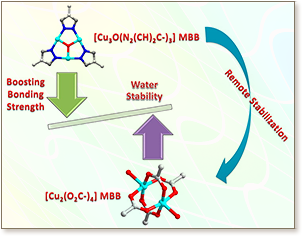

 Copper paddlewheel based molecular building blocks (MBBs) are ubiquitous and have been widely employed for the construction of highly porous metal–organic frameworks (MOFs). However, most copper paddlewheel based MOFs fail to retain their structural integrity in the presence of water. This instability is directly correlated to the plausible displacement of coordinating carboxylates in the copper paddlewheel MBB, [Cu2(O2C−)4], by the strongly coordinating water molecules. In this comprehensive study, we illustrate the chemical stability control in the rht-MOF platform via strengthening the coordinating bonds within the triangular inorganic MBB, [Cu3O(N4–x(CH)xC−)3] (x = 0, 1, or 2). Remotely, the chemical stabilization propagated into the paddlewheel MBB to afford isoreticular rht-MOFs with remarkably enhanced water/chemical stabilities compared to the prototypal rht-MOF-1.
Copper paddlewheel based molecular building blocks (MBBs) are ubiquitous and have been widely employed for the construction of highly porous metal–organic frameworks (MOFs). However, most copper paddlewheel based MOFs fail to retain their structural integrity in the presence of water. This instability is directly correlated to the plausible displacement of coordinating carboxylates in the copper paddlewheel MBB, [Cu2(O2C−)4], by the strongly coordinating water molecules. In this comprehensive study, we illustrate the chemical stability control in the rht-MOF platform via strengthening the coordinating bonds within the triangular inorganic MBB, [Cu3O(N4–x(CH)xC−)3] (x = 0, 1, or 2). Remotely, the chemical stabilization propagated into the paddlewheel MBB to afford isoreticular rht-MOFs with remarkably enhanced water/chemical stabilities compared to the prototypal rht-MOF-1.